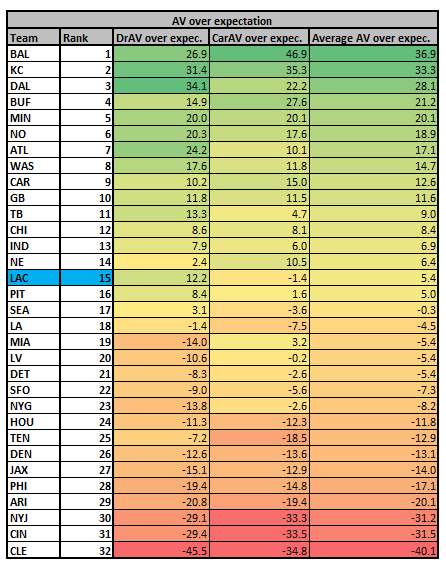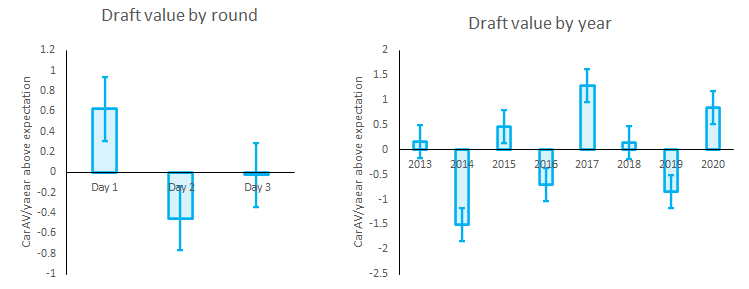Whether Tom Telesco is a good drafter seems like one of the more contentious issues in the Chargers fan community. Some point to the superstars he’s drafted like Bosa, Keenan, Herbert, and Derwin as proof he’s good. Others counter that he’s had enough high picks that you’d expect him to walk away with some stars, and in fact, you should expect more. Really, the question boils down to how he’s doing relative to expectations.
To formally define what we are expectations ought to be, I used a mathematical approach called machine learning which operates by training a computer model through exposing it to known inputs (i.e., “here are patients symptoms”) and known outputs (i.e., “here was their diagnosis”). Using this model that was created through training it can then make predictions about novel inputs (“Here are a new patient’s symptoms. What is the diagnosis?”) Machine learning can be used in a variety of different ways including forecasting weather, detecting fraud, and playing the stock market.
Here I trained the model on data from 2013-2020 drafts by looking at the drafts of the other 31 teams (draft slot, position played, year) and how well those players did using a Approximate Value or (AV) as the measure of how they did. Based on that model, it would then predict how much value you would have expected the Chargers to have gotten with their picks. If Telesco is good at drafting, he would have outperformed that expectation; if he’s a bad drafter, he would have underperformed that expectation.
How does Telesco fare?
Below, I’m showing the results just for Telesco (2013-2020 drafts). There are two versions of AV, and they give two slightly different results. The horizontal axis is the amount of AV expected for that pick. The vertical axis is the actual amount of AV, and the line is unity (slope = 0). Players that outperform expectations are above the line, players that don’t are below.
- The first is total AV for the team that drafted a player. Both for the Chargers predictions and the training data used for the other 31 teams, it’s looking at only the AV given to the drafting team, so their success on other teams does not figure in.
- The second is career AV, which counts the total AV regardless of which team the player is playing for.

When I guy is a homerun pick like Keenan Allen or a total bust like Chris Watt both models pick them up as such. In aggregate though, these two models of AV give somewhat different opinions. The first case actually has Telesco getting value bit above expectations (good drafter), and the 2nd says he’s getting below expectation (bad). DJ Fluker is a good example of a player whose AV really depends on which method is used. I don’t think either perspective/model is intrinsically better so I’ll present both throughout.
Next, I took this same approach for all 32 teams (build a model based on 31 teams, make predictions for the team in question) to understand how much each team is overperforming or underperforming expectations.
Getting confidence in the mode
Here we’re looking at a team that we thinking of as a bad drafter (the Jets) and a good drafter (the Cowboys) in the draft. For both the draft team AV and career AV (not shown) the results make sense: The Chargers are vastly outperforming the Jets and the Cowboys are vastly outperforming the Chargers.

Going forward, I’m using a slight tweak that looks at AV/year rather than AV as this better allows me to better compare across drafts. It hardly affects overall results, but I want to be transparent about this tweak.
Leaguewide since 2013, here are the 5 biggest plays that most overperformed and underperformed expectations for each model:

These seem like reasonable lists and I think validates the approach. The only name that really pops out as “off” is Jeff Okudah, who makes both lists. It feels premature to label him as such. Still, I also understand the model’s logic, given how much he underperformed expectations in his lone season.
How does Telesco fare relative to the rest of the league?

You can see that Telesco is 10th in one model and 18th in another. Again, I don’t think one is inherently better, and when averaged, Telesco is slightly above average at 15th.

I also wanted to look at model disagreement to see which teams one model liked more than the other. I’ve colored it differently than other tables to emphasize that this isn’t good vs bad (having both models agree that you suck isn’t a good thing, for example) but just about model disagreement.

On one end of the spectrum we have the Ravens, who the career AV model likes a lot more than the draft team AV. This makes sense given the teams “draft-develop-let walk-comp pick” model where a lot of their good players get AV on other teams, and the Ravens are compensated with picks. Just below them are the Dolphins whose players get Gased before going on to do well on other teams. On the other end are the Falcons, who the draft team AV model loves, but the career AV model not so much. This makes sense given how many of their stars are homegrown but also how few do much after the leave the team.
Telesco’s Drafting – Odds and Ends

Last but not least I wanted to just hit on a few notable findings about Telesco’s drafting, none of which probably comes as a surprise.
1. He is getting way above average value on Day 1, way below average value on Day 2 and then is pretty much dead on average on Day 3. His day one drafting is what is responsible for the good overall value as he’s ranked 24th after on Days 2 and 3 combined.
2. 2017 was Telesco’s best draft, 2014 his worse. In fact, on a value-for-pick basis, the model has his 2014 draft as the worst draft by any team in any year .
tl;dr – All the numbers point to Telesco being a pretty average drafter. There are a few things to consider though. Where are things headed?
The way this metric is put together, the younger players could see big changes in AV that could really things. A healthy year from Derwin James, a breakout season for Adderley. or PFF’s predicted regression of Herbert (but see this and this) could make big differences in either direction. We’re probably seeing Telesco’s rankings in the teens regardless though.
Another shift I foresee is with the 2017 class (the one rated best) almost entirely not being re-signed we can expect that this class to start looking worse with the draft team AV model, but they’ll probably look better by the career AV model. Whether those results are equal and opposite remains to be seen.